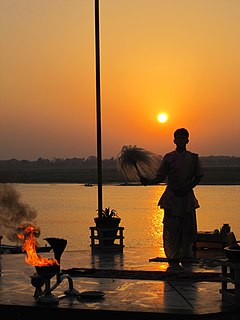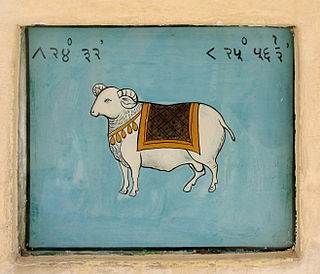Related Research Articles
The Hindu calendar or Panchang, or Panjika, refers to a set of various lunisolar calendars that are traditionally used in the Indian subcontinent and South-east Asia, with further regional variations for social and Hindu religious purposes. They adopt a similar underlying concept for timekeeping based on sidereal year for solar cycle and adjustment of lunar cycles in every three years, however also differ in their relative emphasis to moon cycle or the sun cycle and the names of months and when they consider the New Year to start. Of the various regional calendars, the most studied and known Hindu calendars are the Shalivahana Shaka found in the Deccan region of Southern India, Vikram Samvat (Bikrami) found in Nepal, North and Central regions of India – all of which emphasize the lunar cycle. Their new year starts in spring. In contrast, in regions such as Tamil Nadu and Kerala, the solar cycle is emphasized and this is called the Tamil Calendar and Malayalam calendar, their new year starts in autumn, and these have origins in the second half of the 1st millennium CE. A Hindu calendar is sometimes referred to as Panchangam (पञ्चाङ्ग), which is known also known as Panjika in Eastern India.

Mangala is the name for Mars, the red planet, in Hindu texts. Also known as Lohit, he is the god of anger, celibate and sometimes linked to god Kartikeya (Skanda). His origins vary with different mythological texts; in most texts, he is the son of Bhumi, the Earth Goddess and Vishnu, born when he raised her from the depths of water in Varaha avatar. In other myths, he is born from Shiva's sweat or blood drop.

Pausha is a month of the Hindu calendar and as well in the Indian national calendar; it's the tenth month of the year, corresponding with December/January in the Gregorian calendar.
The Tamil calendar is a sidereal Hindu calendar used by the Tamil people of the Indian subcontinent. It is also used in Puducherry, and by the Tamil population in Malaysia, Singapore, Mauritius and Sri Lanka. Tamil Nadu farmers greatly refer to this. It is used today for cultural, religious and agricultural events, with the Gregorian calendar largely used for official purposes both within and outside India. The Tamil calendar is based on the classical Hindu solar calendar also used in Assam, West Bengal, Kerala, Manipur, Nepal, Odisha, Rajasthan and Punjab This shows Hindus were well versed about planetary movements.
Vṛścika, also referred to as Vrishchika or Vrschika, is a month in the Indian solar calendar. It corresponds to the zodiacal sign of Scorpio, and approximately overlaps with the later half of November and first half of December in the Gregorian calendar.

The Sūrya Siddhānta is a Sanskrit treatise in Indian astronomy in fourteen chapters. The Surya Siddhanta describes rules to calculate the motions of various planets and the moon relative to various constellations, and calculates the orbits of various astronomical bodies. The text is known from a 15th-century CE palm-leaf manuscript, and several newer manuscripts. It was composed or revised c. 800 CE from an earlier text also called the Surya Siddhanta.

Saura is a term found in Indian religions, and it connotes "sun" (Surya) or anything "solar"-related.
Samvatsara (संवत्सर) is a Sanskrit term for a "year" in Vedic literature such as the Rigveda and other ancient texts. In the medieval era literature, a samvatsara refers to the "Jovian year", that is a year based on the relative position of the planet Jupiter, while the solar year is called varsha. A jovian year is not equal to a solar year based on the relative position of Earth and Sun. A Jovian year is defined in Indian calendars as the time Brihaspati (Jupiter) takes to transit from one constellation to the next relative to its mean motion.
Karkaṭa, also referred to as Karka or Karkatha, is a month in the Indian solar calendar. It corresponds to the zodiacal sign of Cancer, and overlaps approximately with the later half of July and early half of August in the Gregorian calendar.

Meṣa, or Mesha (मेष), is a month in the Indian solar calendar. It corresponds to the zodiacal sign of Aries, and overlaps with about the second half of April and about the first half of May in the Gregorian calendar. Generally Mesha month starts on 13th or 14th of April, called as Mesha Sankranti.
Vṛṣabha, or Vrishabha, is a month in the Indian solar calendar. It corresponds to the zodiacal sign of Taurus, and overlaps with about the second half of May and about the first half of June in the Gregorian calendar. The first day of the month is called Vrishbha Sankranti, and it generally falls on May 14th or 15th.
Siṃha is one of the twelve months in the Indian solar calendar.
Kanyā is one of the twelve months in the Indian solar calendar.
Tulā is one of the twelve months in the Indian solar calendar.
Mīna, or Meena, is a month in the Indian solar calendar. It corresponds to the zodiacal sign of Pisces, and overlaps with about the later half of March and about the early half of April in the Gregorian calendar. First day of the Meena month, called as Meena Sankranti generally falls on March 14th.

Mesha Sankranti refers to the first day of the solar cycle year, that is the solar New Year in the Hindu luni-solar calendar. The Hindu calendar also has a lunar new year, which is religiously more significant, and falls on different dates in the Amanta and Purinamanta systems prevalent across the Indian subcontinent. The solar cycle year is significant in Assamese, Odia, Punjabi, Malayalam, Tamil, and Bengali calendars.
Makara is a month in the Indian solar calendar. It corresponds to the zodiacal sign of Capricorn, and overlaps with about the later half of January and approximately early half of February in the Gregorian calendar.
Dhanu, Dhanus or Dhanurmas (धनुर्मास) is a month in the Hindu calendar, Malayalam calendar and others. It corresponds to the zodiacal sign of Sagittarius, and overlaps with approximately the second half of December and about the first half of January in the Gregorian calendar.
Kumbha is a month in the Indian solar calendar. It corresponds to the zodiacal sign of Aquarius, and overlaps with about the second half of February and about the first half of March in the Gregorian calendar.
The traditional New Year in many South and Southeast Asian cultures is based on the sun's entry into the constellation Aries. In modern times, it is usually reckoned around the 14th of April.
References
- 1 2 3 James G. Lochtefeld (2002). The Illustrated Encyclopedia of Hinduism: N-Z (Vol 1 & 2). The Rosen Publishing Group. p. 40. ISBN 978-0-8239-3179-8.
- 1 2 Robert Sewell; Śaṅkara Bālakr̥shṇa Dīkshita (1896). The Indian Calendar. S. Sonnenschein & Company. pp. 5–11, 23–29.
- ↑ Nachum Dershowitz; Edward M. Reingold (2008). Calendrical Calculations. Cambridge University Press. pp. 123–128. ISBN 978-0-521-88540-9.
- ↑ Christopher John Fuller (2004). The Camphor Flame: Popular Hinduism and Society in India. Princeton University Press. pp. 291–293. ISBN 978-0-69112-04-85.
- 1 2 3 Robert Sewell; Śaṅkara Bālakr̥shṇa Dīkshita (1896). The Indian Calendar. S. Sonnenschein & Company. pp. 10–11.
- ↑ Bangalore V. Raman (2003). Studies in Jaimini Astrology. Motilal Banarsidass. pp. 10–19. ISBN 978-81-208-1397-7.